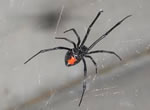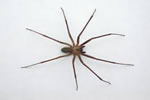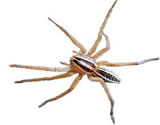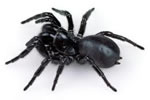Sydney Funnel Spider
The Sydney funnel spider is a large Australian spider that can grow up to two inches in length. These spiders are normally found in or outside of Sydney, Australia, where they frequent sandy areas with rocks or logs. These spiders build elaborate burrows in tree limbs. Burrows come equipped with "trip-wires," silk threads that alert the spider when potential prey is near. When insects, lizards or frogs walk across the silk thread, the spider rushes out from its burrow and attacks by injecting venom.
Sydney funnel spiders will bite humans if they feel threatened and will rise up on their hind legs to display their fangs. Unlike most spiders, these grip their victims tightly and often bite repeatedly. The bite from this spider is said to be very painful and is considered a medical emergency due to its toxic nature. Because of an anti-venom developed by scientists in 1981, there have been no recorded fatalities since. Bites from male spiders are more dangerous than those from female spiders.
Back to top
Goliath Bird-eating Tarantula
The goliath bird-eating tarantula is the world's heaviest spider and second largest in length. They can weight as much as six ounces. The leg span of an adult female can reach eleven inches in length. Like other tarantulas, the body can be tan, brown, grey, or black. Interestingly, females can live up to 25 years whereas males have a maximum life span of about six years. Despite its name, this spider rarely, if ever, preys on birds. Its diet is largely made up of insects, but also includes small reptiles, amphibians, and mammals. This nocturnal spider is found in the Amazon regions of South America, particularly in wet or swampy habitats.
The goliath bird-eating tarantula will only bite humans if provoked. The bite is painful (equal to the sting of a wasp) but rarely harmful. Sometimes, these spider "dry bite," which means they bite without injecting venom.
Back to top
Black Widow Spider
The black widow spider is characterized by black body and legs, and tell-tale red hourglass marking on the underside of its abdomen. Females can grow to lengths of about 1.5 inches. Males are smaller but have longer legs.
The black widow spider is one of the most feared spiders in the world. It's venom is extremely poisonous and is said to be at least 15 times more poisonous than the venom of a rattlesnake. Black widow spiders are found in many parts of the world, but in the United States are limited to the warmer climates of the southern and western portions of the county. Black widow spiders are fond of dark places such as under rocks or logs. In houses and buildings, they may take up residence in closets, furniture, pipes, or in basements. After a female and a male mate, the female often kills and eats the male, hence the name black "widow."
Black widow spiders eat other insects that they catch in their webs. Unlucky victims are injected with venom which liquefies their insides. The spider can then easily consume its prey. Black widow spiders will bite humans when they feel threatened. While the venom is not toxic enough to normally cause death, it is extremely painful, and is often severe enough to require hospitalization. Headaches, chest or abdominal pain, muscle cramps, and trouble breathing are the most common symptoms.
Back to top
Wolf Spider
The wolf spider is a large, dark-colored spider. wolf spiders are actually a family of different spiders with similar characteristics. Unlike most spiders, wolf spiders stalk and attack prey, rather than spinning a web to catch prey. There are over 2,300 different kinds of wolf spiders, with 200 or so found in America. They are found in a variety of habitats including grasslands, forests, wetlands, and deserts.
Wolf spiders vary in appearance. They can be black, brown, spotted or striped. Large females can approach 1.4 inches in length. Males are usually smaller. Female wolf spiders are more attentive to her young than most spiders. Baby spiders are carried around on their mother's back until they are ready to fend for themselves.
Although wolf spiders aren't aggressive toward humans, they will bite if provoked. Wolf spider bites may cause redness, swelling, and pain, but their venom is not normally harmful to humans.
Back to top
Huntsman Spider
Huntsman spiders are found all over the world, but most are found in Asia. The name is derived from the fact that these spiders hunt down their prey rather than catch prey in webs. Recently, a giant huntsman spider found in a cave in Laos (a nation in southeast Asia) was measured to have a twelve-inch leg span, making it the longest spider ever discovered. Most huntsman spiders, however, are much smaller and average about an inch in length, with a leg span of five inches. Many of these spiders have flattened bodies, making it easy for them to squeeze into small openings. Specialized joints allow huntsman spiders to move side-to-side (crab-like) better than most spiders. They also tend to move much faster than ordinary spiders.
Huntsman spiders can be found under rocks, within tree bark, in logs, or in other dark places. Huntsman spiders are known to congregate in groups on tree stumps or on exposed perches. These spiders prey largely on cockroaches and other insects pests, and thus, are considered valuable for pest control. Huntsman spiders will only bite humans if provoked. Bites are painful but usually harmless.
Back to top
Brown Recluse Spider
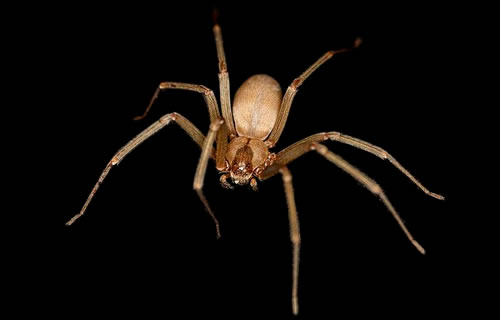
The brown recluse spider gets its name from its drab brown coloring and its habit of living a solitary existence. These spiders are characterized by a violin-shaped marking on the back of the neck. While many spiders have eight eyes, the brown recluse has six eyes organized into three "dyads." Brown recluse spiders are small spiders rarely exceeding 3/8 of an inch in length.
These spiders are most common in the southern plain states of Kansas, Missouri, Oklahoma, Arkansas, Texas, Louisiana and Alabama. They are also established in Illinois, Indiana, Ohio, Kentucky, and Tennessee. This spider loves dark places and is normally found under porches, in log piles, old tires, or in drains. Inside the house, brown recluse spiders may be found in dark basements, closets, or in trash cans.
Brown recluse spiders will bite humans when threatened, although their bite is only powerful enough to puncture skin; it cannot bite through clothing. Although different people will experience a wide range of intensity of symptoms (some will experience little pain or minor symptoms while other experience intense pain and symptoms), a brown recluse spider bite normally requires medical attention, although there is currently no anti-venom for a bite from this spider. Some individuals (about 10% of those who are bitten) experience major tissue damage, necrosis (decay of skin and tissue) and infection as a result of a bite from this spider. In rare cases, individuals require the amputation of the affected limb.
Back to top
American House Spider

The American house spider is a familiar visitor to homes, garages and sheds across the country and in many parts of the world. American house spiders are brownish in coloration and females have dark speckles on the abdomen. Females can be twice as large and males and max out at about 1/2 inch in length. Males are typical about 1/4 or 18 inch in length.
American house spiders prey on small insects that become stuck in their sticky webs (known as cobwebs). Hapless insects are bitten, injected with venom and stored in the web to be eaten later. American house spiders are fairly harmless and non-aggressive. If disturbed, they will sometimes try to play dead. Although they occasionally bite, their venom is non-toxic.
Back to top
Desert Tarantula
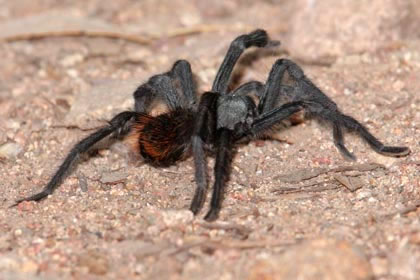
The storied, yet shy, desert tarantula is a common resident of the American Desert Southwest and Mexico. These spiders can grow to reach nearly three inches in length (although its legs may extend as long as four inches) and are characterized by their heavy, hairy bodies, which may be tan, brown, grey, or black in coloring. Female tarantulas tend to be lighter in coloring than males. Since tarantulas have poor eyesight, the hairs on its body help it sense things in its environment, determine wind direction, and pick up on chemical signals. The hairs also serve a defensive function as they tip with backward-facing barbs that can injure the eyes and skin of would-be predators.
Desert tarantulas prey upon insects, small reptiles, and small mammals. Contrary to their portrayal in popular culture, tarantulas are non-aggressive toward humans and will flee rather than attack. Tarantulas will bite humans with their large fangs if threatened, but the bite is said to be no more painful than a bee sting.
Back to top
|
